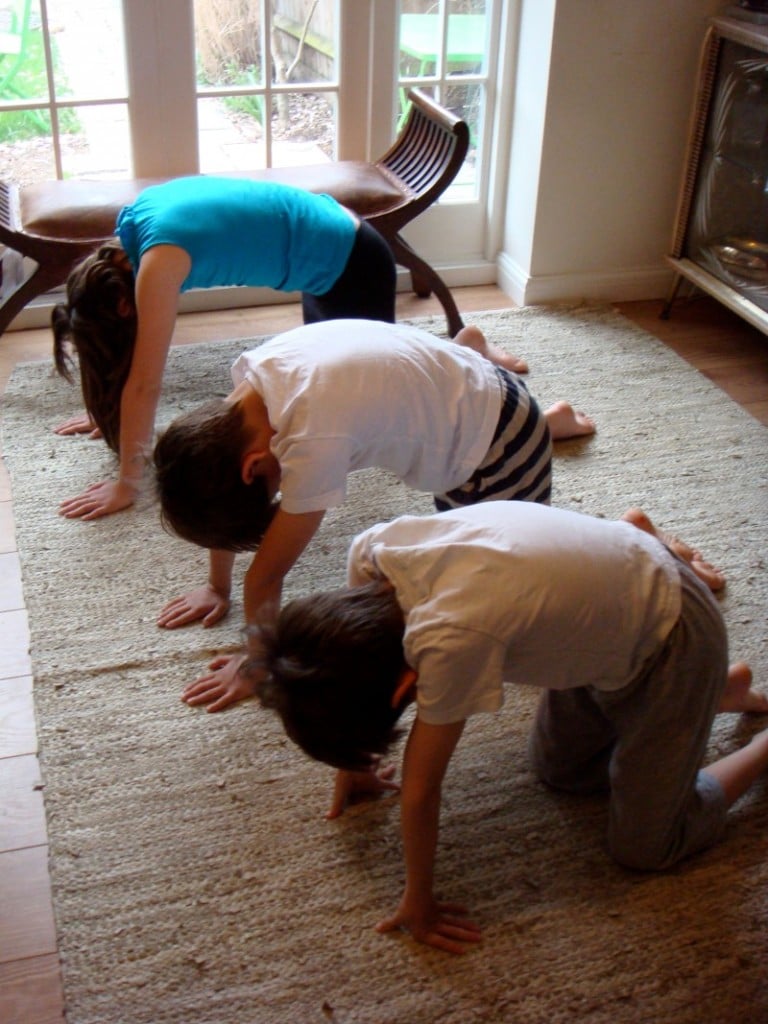I love teaching yoga to children but it’s a totally different skill set to teaching babies! If you are thinking about teaching toddler or child yoga it’s important to be prepared and learn how to manage the dynamic in the classroom. Yoga should be imaginative and fun but it can’t be completely chaotic and crazy! It also has to be safe so children need to know the boundaries of what you can and can’t do in a class. I taught children’s yoga in lots of settings from gyms, to home school groups, to childrens’ centres, nurseries and schools. I have listed some of my top tips on helping to control your class dynamic when teaching older children yoga;
Using names
If you refer to children by their names you can engage them directly and it also helps to build up a relationship of trust and familiarity.
Boundaries
When teaching adults, you gain consensus on what is acceptable behaviour in the class through the use of ground rules. With children we can use a similar technique by establishing boundaries. At the beginning of the session, you can set out the boundaries of the class so that the children know what is expected of them. You can do this in a light hearted way with humour and kindness. The boundaries do not need to set out like a list of rules.
It is important that children understand the boundaries to establish respect for you as the teacher and for other children in the class. What is acceptable behaviour in your class is down to you but might include things such as not talking when you are talking, listening, not leaving the circle etc. A powerful way to reinforce boundaries is to get the children to tell you in their own words what they believe the boundaries of the class are. You may even choose to write the boundaries on a piece of paper and put them on the wall.
Reinforce positive behaviour
It is important to try to reinforce and reward positive behaviour when you are working with children. Generally children will co-operate far more readily if they feel involved in the process of decision making and the suggested activities. Try to find positive praise for individual children rather than “telling off” children. If you reinforce the negative, then this is what the children are more likely to remember.
Channelling positive energy
Children will get excited during the class and may not want to stop doing certain activities if they are enjoying them. It can be difficult to redirect this energy and enthusiasm into other things. You will need to create ways of gaining children’s attention when you need it. This maybe by clapping your hands in a steady rhythm and asking the children to join in to get their attention or by ringing a bell or by getting them to quickly run back to their mats and sit down. Reinforcing boundaries will be important here again.
Parents co-operation on behaviour
Parents are present during the class so it is important to get them on side in maintaining boundaries and positive behaviour. Parents have responsibility for their children in the class so it is useful to explain to them what is expected of them. If a child is being disruptive then it may be appropriate to have a private word with the parent at the end of the class to discuss how to help the child feel more comfortable and integrated into the class.
Difficult behaviour
As the teacher in the class you have a duty to all the parents and children in the class to create a relaxing and comfortable learning environment. If there is a few disruptive children (or parents) this can effect the enjoyment of everyone in the class. It is your responsibility to make sure that everyone can participant equally in the class. Although it may be tempting to shout, this does not set a good example of how to manage the class. In fact it communicates to the class that you have lost control. Better techniques include talking very quietly in one corner of the room so that the children have to come closer and listen to what you are saying or using the clapping technique described above in the section on positive energy.
Never get into an argument or confrontational situation with a child. It is worth mentioning however, that if a child sees another being disruptive and it is not dealt with by the teacher then this behaviour can spread because children become aware that the teacher is not controlling the behaviour. Children copy both good and bad behaviour!
The best strategy for dealing with bad behaviour is to IGNORE IT. This is not always possible but again, try to observe the principle of rewarding and noticing good and positive behaviour whilst ignoring undesirable behaviour. Give lots of praise to all the children that are behaving appropriately.
The basic rule is to reward and give attention to positive behaviour and to ignore undesirable behaviour. Stickers at the end of the class are also a useful way to reward and encourage good behaviour. When praising children, it is important to emphasise the specific activity which deserves the praise to encourage the whole group to continue with that specific behaviour (i.e sitting still, listening, etc).
Disruptive/Spirited children
If you have a very disruptive child you may have to take a more pro active approach. This may require the child to spend a few minutes outside the circle in the class with his/her parent. This should be a last resort however. The nature of the Story Stretch classes we teach encourages free play and imagination and some children get caught up in the story and can appear to not be participating fully in the yoga poses. The lack of structure in the classes can sometimes lead to some children confusing the boundaries of behaviour so it is important to be clear as the teacher as to what they are.
Shy or anxious children
Some children can feel quite shy in a group or anxious in a new place. It is important to reassure them before the class begins and discuss with parents what will happen in the classes to create as supportive and friendly atmosphere as possible. Parents/carers are the most important people to help a shy or anxious child settle in.
Gaining the focus of the class.
It can be difficult to gain the focus of all the children in the class to make sure that they are copying you and taking instructions. A good way to gain attention is to say
“If you are listening to me…put your hands on your head/sit down/fold your arms”.
Generally the younger the children, the more difficult it is to gain their attention for long periods of time.
Keeping your own personal space
Some children struggle with the concept of personal space and boundaries both with you as the teacher and with other children. A good way to keep personal space defined is to ask the children to take ownership of their mats and treat them like their “base”, a space in the room they can go back to.Using circle work can also be a useful way of containing children within a certain area.
I hope this is helpful and full details of our classes for older children are on the website and we teach them as part of our full Nurture Diploma too.
Love
Gayle xx

